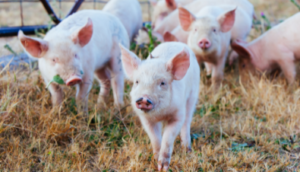Whether you own a commercial piggery, 10 sows, or a pet pig, we are all part of the one community – the Australian pig community! To ensure that our community is protected against diseases, we must all do our part in maintaining good biosecurity on our properties. Biosecurity can be simple and practical while still being cost-effective.
Here is a practical checklist for all pig producers to ensure you are doing all you can for your pigs and the Australian pig community!
- Have you registered your pig brand (also called a tattoo) or purchased NLIS accredited pig tags?
Registering your pig brand is easy, just contact the office in which you applied for your PIC. Alternatively, NLIS accredited pig tags can be purchased through any agricultural reseller that sells cattle and sheep tags.
o When do you need to use a brand or a NLIS accredited pig tag? This differs in each state – PigPass has a detailed explanation of the legislation in each state.
- Have you registered for a Property Identification Code (PIC)?
Each and every property with a pig must have a registered PIC with their local state agricultural department. Here are the contact details to register for a PIC:
o NSW: apply for a PIC through Local Land Services – Apply for a property identification code, Local Land Services
o Queensland: when you register as a biosecurity entity with Business Queensland you will be allocated the PIC that is associated with the land where you keep your animal(s) – Property identification codes (PICs) | Business Queensland
o Victoria: apply for a PIC through Agriculture Victoria – Application for a Property Identification Code (PIC) (agriculture.vic.gov.au)
o South Australia: apply for a PIC through Department of Primary Industries and Regions – Property Identification Code – PIC Number – PIRSA. Note PICs require re-registration every two years.
o Western Australia: register as an owner of livestock and obtain a PIC through the Department of Primary Industries and Regional Development’s Brand Office – Livestock ownership, identification and movement in Western Australia | Agriculture and Food
o Northern Territory: apply for a PIC through Department of Industry, Tourism and Trade – NT Property Identification Code
o Tasmania: apply for a PIC through Department of Primary Industries, Parks, Water and Environment – Registration for Property Identification Code (PIC) | Department of Primary Industries, Parks, Water and Environment, Tasmania
o ACT: apply for a PIC through the Environment, Planning and Sustainable Development Directorate – Registration of a Property Identification Code (PIC) – ACT – Australian Business Licence and Information Service
- Have you registered with PigPass?
Every pig that will be moved, sold or processed must first be identified with a brand or NLIS accredited pig tag and then recorded on the PigPass database. The PigPass database is Australia’s national tracking system that provides real-time information on all pig movements. If you are moving pigs you are required to fill out your PigPass National Vendor Declaration (available from PigPass) and when you are purchasing or moving pigs onto your property it’s your job to complete the movement history on the PigPass website.
- Have you considered how you can protect your pigs at home from pests and diseases?
Having a biosecurity plan for your property or being involved in the APIQ✓® Quality Assurance Program that is managed by Australian Pork Limited, is the best assurance for your pigs. Information about how to develop a biosecurity plan and how you can ensure the great work you’re already doing is gold standard can be found on the Farm Biosecurity pig industry webpage.
- Have you got the right feed for your pig/s?
“We are what we eat” this old saying applies to our pigs too! Many commercial producers likely have nutritionists helping them design a productive ration, but if you only have a few pigs, or maybe a pet pig, what resources are available to you? The NSW Department of Primary Industries’ Prime Fact on pig nutrition is a great place to start. Feeding a commercial pig feed is a good way to ensure that you are matching your pig’s needs with the quality of feed.
o Did you know that it is illegal to feed your pig(s) any swill (also called prohibited pig feed)? Swill is meat, meat by-products or products that may have come into contact with meat. Why is feeding swill illegal? Feeding swill is a high-risk practice because it can lead to outbreaks of exotic diseases such as African swine fever, foot and mouth disease (FMD) and Aujeszky’s disease. If Australia had an outbreak of any of these diseases, the ramifications could include a total industry shut down, or worse, a shutdown of the sheep and cattle industries as well in the case of a FMD outbreak.
- Do you have the number of a pig veterinarian or local district veterinarian saved?
It’s always good practice to ring for help if you notice any signs of illness or something unusual in your pig(s).
Remember good biosecurity at home will save our pig community’s bacon in the long run!
